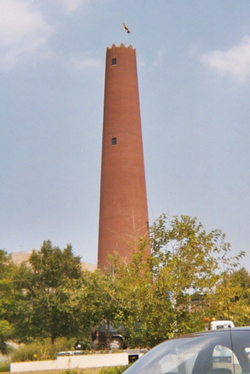Phoenix Shot Tower
|
Shot Tower
|
|

Phoenix Shot Tower
|
|
| Location | Baltimore, Maryland |
|---|---|
| Coordinates | 39°17′26″N 76°36′20″W / 39.29056°N 76.60556°WCoordinates: 39°17′26″N 76°36′20″W / 39.29056°N 76.60556°W |
| Built | 1828 |
| Architect | Unknown |
| NRHP Reference # | 69000373 |
| Significant dates | |
| Added to NRHP | October 1, 1969 |
| Designated NHL | November 11, 1971 |
The Phoenix Shot Tower, also known as the Old Baltimore Shot Tower, is a red brick shot tower, 234.25 feet (71.40 m) tall, located near the downtown, Jonestown (also known later as Old Town), and Little Italy communities of East Baltimore, in Maryland. When it was completed in 1828 it was the tallest structure in the United States. The tower was originally known as the "Phoenix Shot Tower", then the "Merchants' Shot Tower", and now is also sometimes called the "Old Baltimore Shot Tower". It was designated a National Historic Landmark on November 11, 1971.
The Shot Tower lends its name to the nearby Shot Tower/Market Place station on the Baltimore Metro subway system's northeast line.
The tower was built by Jacob Wolfe using bricks manufactured by the Burns and Russell Company of Baltimore. Charles Carroll of Carrollton, the last surviving signer of the Declaration of Independence, a Roman Catholic lay leader and wealthiest man in America at that time, laid its cornerstone.
The circular brick structure's walls are 4.5 feet (1.4 m) thick from the bottom to about 50 feet (15 m) up; then they narrow in stages of 4 inches (10 cm) each, until reaching a thickness of 21 inches (53 cm) at the top.
Molten lead was dropped from a platform at the top of the tower, through a sieve-like device, into a vat of cold water at the bottom of the tower to produce both "drop shot" for pistols and rifles and "moulded shot" for larger weapons such as cannons. When hardened, dried, and polished, the shot was sorted into 25-pound bags. The annual production was about 100,000 bags of shot a year, with the capability of doubling that in case of war or other high demand.
The tower stopped producing shot in 1892, when a new method of making shot made the tower obsolete. It re-opened for a brief period of production at the beginning of the twentieth century, and then closed for good.
...
Wikipedia



